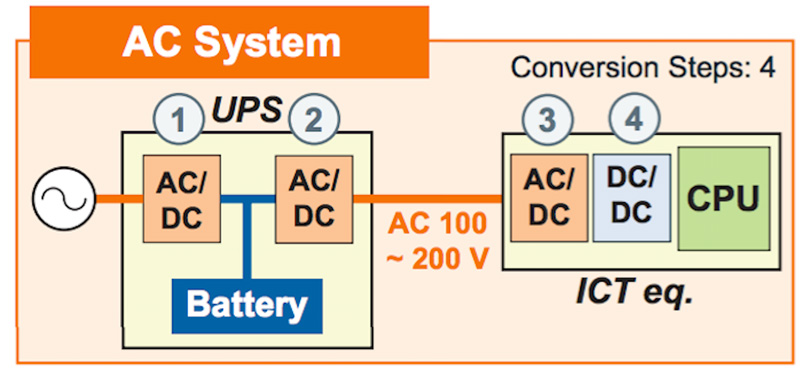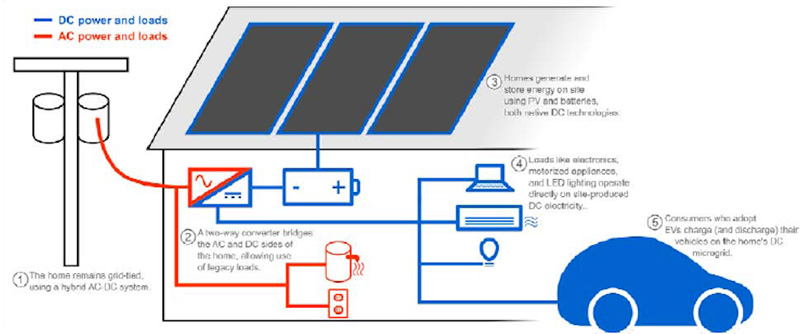Why DC only distribution makes sense for energy savings
The drive for energy conservation, the DC basis of modern electronic systems, and the development of renewable energy sources have converged to challenge the 100 year old assumption that AC alone is the single best means of distributing electricity.
Instead, a combination of AC for the main grid and DC for micro and nano grids is shaping up to be a more energy efficient path, if industries and engineers come together to define the necessary standards and implement them effectively.
The potential of DC-only power distribution to conserve energy came to the fore as datacenters expanded with the Internet. It became apparent that powering these massive data crunching and storage facilities was becoming an increasingly large part of a company’s overhead, and any efficiencies gained went right to bottom line.
This initiated a re-think of the energy distribution system for Information and Communications and Technology (ICT) systems that resulted in a shift from multiple AC/DC and DC/AC conversion stages, to a single AC/DC stage, with DC-only distribution using DC/DC converters and regulators to power the servers’ various DC rails (Figure 1).

Figure 1: The typical AC distribution system for a datacentre or building requires four stages of conversion, with each stage having its own inherent losses. (Image source: Vicor Corp.)
This has four stages of conversion, with an Uninterruptible Power Supply (UPS) battery coming right after the first AC/DC stage. The inherent losses added up and spurred the drive to the formation of high voltage standards such as the 380-V EN 300 132-3-1 standard defined by the European Telecommunications Standards Institute (ETSI).
Moving to high voltage DC allows adequate power delivery at lower currents (power = voltage x current), thereby reducing cabling and connector losses. This higher voltage can then be stepped down using what are now highly efficient (96%) DC/DC converters to deliver the right voltage to the right circuits. What was once a four stage AC/DC conversion now becomes a two stage conversion of AC to DC.

Figure 2. Moving to a high voltage DC system reduces greenhouse gas emission and lowers total costs of ownership by reducing conversion and cabling losses, increasing reliability, and lowering the number of system elements. (Image source: Vicor Corp.)
With US data centres alone consuming about 70 billion kilowatt-hours of electricity in 20141, representing 2% of the country’s total energy consumption, any increase in efficiency can have a major impact. Without the adoption of high efficiency techniques and technologies, including high voltage DC, those same US datacentres could have consumed 40 billion more kilowatt-hours to do the same amount of work.
DC for the home
While datacentres have received much attention, the increased of DC-based electronic systems in the home have raised the possibility of energy savings by migrating to full DC distribution there too. Between computers, TVs, embedded electronics, and LED/CFL lighting, up to 70% of today’s residential loads either requires or could easily be converted to operate on DC power3.
The home owner’s desire to be both eco-friendly while also saving over the long terms is another reason moving to DC is attractive: it allows for the integration of renewable energy sources, such as solar power. This applies to all buildings and factories where solar, as well as wind and other renewable sources can be used. With DC-only distribution, the inverter conversion loss of five percent can be can be eliminated.

Figure 3. Up to 70% of home can run on DC, with only major appliances such as washers and dryers requiring an AC feed. (Image source: ACEEE Summer Study on Energy Efficiency in Buildings)
However, that’s only the start of the savings: all the AC/DC converters required for every electronic device in the home - from TVs to cellphone chargers - can be eliminated or replaced by highly efficient DC/DC modules. All that’s required is the desire and the commitment to so.
The desire has already been demonstrated by standards bodies such as ETSI, as well as the IEEE and International Electrotechnical Commission (IEC), which have developed standards or are in the process of doing so. The US Department of Energy has even established a Data Center Energy Practitioner (DCEP) Training program4 to accelerate energy-conservation best-practices awareness, which includes moving to DC. For commercial buildings, look to the work of the Emerge Alliance to start on the road to all-DC adoption.
The commitment to moving to DC must come from the engineers who understand the redundancies, inefficiencies and waste of the current multiple-conversion, high-loss AC distribution grids. From conversion and cable losses, to redundant converters, transfer switches, and AC/DC converter blocks for every electrical device. Just the simple act of making and shipping these blocks alone contributes to unnecessary energy consumption.
Tesla and Westinghouse won the early battle against Edison over AC vs DC, and it may have been appropriately so, given the technology available at that time. But much has changed since then to allow us to strike the right balance between AC and DC using current, highly efficient semiconductors and DC/DC converter topologies, combined with governments, standards bodies, and engineering know-how on the ground.










